


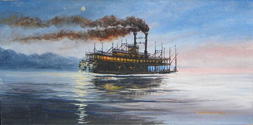
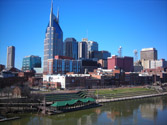
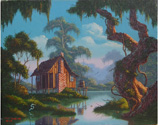
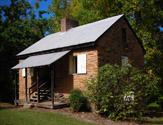









Magnolia Eden
Daffodils in Early Southern Gardens
By SaraVan Beck
The southern daffodil is a quintessential pass-along plant, tough enough to handle the weather, easy to share, and lovely enough to covet some from your friends or relatives. But past the inherent knowledge that these bulbs have been around for an awefully long time, it hasn't been until the internet age that actually tracing the planting and spread of daffodils across the South has become possible. As garden historians collect and share their research, little tidbits emerge. Some of those daffodils out in the field may be much older than you'd guess.
Early Settlers and Their Daffodils
While everyone says in an off-handed way that the immigrants from England and Continental Europe brought daffodils (botanically known as narcissuses) with them, it is much harder to prove! One of the first recorded discussions of colonists bringing daffodils along with them is in letters between John Bartram (of the Bartram Trail) in Philadelphia and Peter Collinson (one of his main English providors, co-enthusiasts and co-Quaker) in 1763. In 1740, Collinson shipped Bartram 40 varieties of narcissus, but unfortunately he didn't list them out by name; some time in the 1730s Collinson shipped twenty narcissus types off to another colonial plants enthusiast, John Custis. In 1763, Collinson, wrote to Bartram of his great delight in finally finding the white double daffodil now often known as "Albus Plenus Odoratus"(now called 'Plenus'). In his reply, Bartram wrote (once they get their plant names straightened out, for Bartram calls it "Double Sweet Daffodil" while Collinson calls it "Sweet White Narcissus"): "If I had known the White Double Daffodil had been such a rarity to thee, I could have sent thee large quantities thirty years ago. Our first settlers brought them with them, and they multiply so that thousands are thrown away." (Oct. 23, 1763)
The southern daffodil is a quintessential pass-along plant, tough enough to handle the weather, easy to share, and lovely enough to covet some from your friends or relatives. But past the inherent knowledge that these bulbs have been around for an awefully long time, it hasn't been until the internet age that actually tracing the planting and spread of daffodils across the South has become possible. As garden historians collect and share their research, little tidbits emerge. Some of those daffodils out in the field may be much older than you'd guess.
Early Settlers and Their Daffodils
While everyone says in an off-handed way that the immigrants from England and Continental Europe brought daffodils (botanically known as narcissuses) with them, it is much harder to prove! One of the first recorded discussions of colonists bringing daffodils along with them is in letters between John Bartram (of the Bartram Trail) in Philadelphia and Peter Collinson (one of his main English providors, co-enthusiasts and co-Quaker) in 1763. In 1740, Collinson shipped Bartram 40 varieties of narcissus, but unfortunately he didn't list them out by name; some time in the 1730s Collinson shipped twenty narcissus types off to another colonial plants enthusiast, John Custis. In 1763, Collinson, wrote to Bartram of his great delight in finally finding the white double daffodil now often known as "Albus Plenus Odoratus"(now called 'Plenus'). In his reply, Bartram wrote (once they get their plant names straightened out, for Bartram calls it "Double Sweet Daffodil" while Collinson calls it "Sweet White Narcissus"): "If I had known the White Double Daffodil had been such a rarity to thee, I could have sent thee large quantities thirty years ago. Our first settlers brought them with them, and they multiply so that thousands are thrown away." (Oct. 23, 1763)
Colonial period recordings of daffodils in southern gardens are scant (at this point). But very early on, colonists embarked on softening and beautifying their new environs. Thomas Ashe, in 1682, commented on the new inhabitants of Carolina: "Their Gardens also begin to be beautified and adorned with such Herbs and Flowers which to the eye and Smell or Eye are pleasing and agreeable, viz. the Rose, Carnation and Lilly, &c." One early southern notation of daffodils comes from the Moravian settlement of Bethabara, North Carolina. Brother Lung, on May 1, 1759, laid out the upland garden, and included the daffodil Narcissus pseudonarcissus, the ubiquitous little yellow trumpet of South Carolina and Georgia (made famous by poet William Wordsworth).
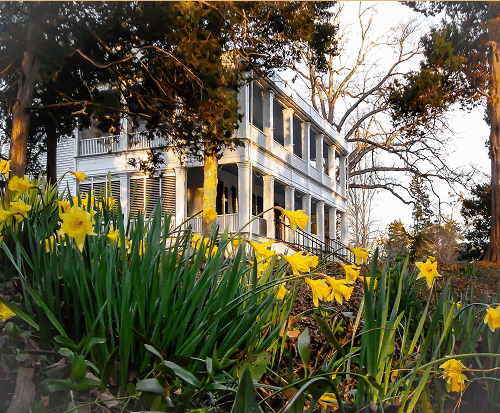
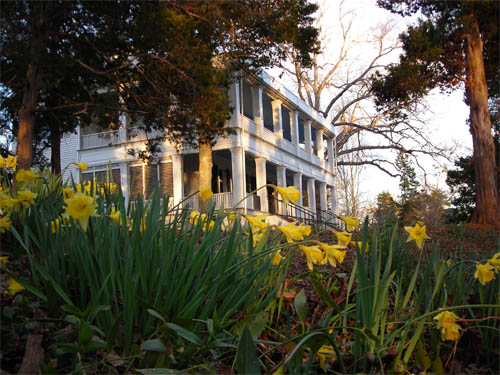
Narcissus pseudonarcissus in bloom at Woodburn Plantation, Pendleton, South Carolina
In 1793, the Lady Skipwith of Prestwould, on the Dan River, Virginia, wrote a detailed account of the flowers in her garden. Although not as detailed as with other plants and as some scientifically-minded men, she provided sufficient information to give a fair guess as to her narcissuses. She grew three double variegated narcissuses, a double jonquil, and three polyanthus narcissuses. Given written accounts of other doubles grown in America around 1800 to 1810, it is tempting to speculate her doubles were 'Butter and Eggs', 'Orange Phoenix' and 'Sulphur Phoenix' ('Eystettensis' is a uniform yellow in coloration, and "Albus Plenus Odoratus" was usually described separately).
After the war, American scientific endeavors expanded, and more individuals and institutions established botanic gardens. Some were apparently partially for profit, others for purely scientific research.
One notable botanic garden was established around 1810 by Louis LeConte at his familial rice plantation, Woodmanston, located 40 miles southwest of Savannah. His focus was bulbs, although his more readily known claims to fame were his collection of camellias and his introduction of the "LeConte Pear" (given to him by his brother John Eatton LeConte). He grew 40 genera of bulbs, and top of his 1813-1815 observation data list were twelve narcissuses. True to the day, many of his daffodils are doubles, but he also grew two types of paperwhites---well-known to coastal South gardeners, but rarely ever appearing in historic gardening literature. LeConte recorded the dates of sprouting, flowering and senescense. LeConte's daffodils were two strains of paperwhites, N. tazetta, N. jonquilla, N. x odorus, N. incomparabilis (now a group name), 'Sulphur Phoenix', 'Butter and Eggs', N. pseudonarcissus, N. pseudonarcissus fl.pl. (likely 'Plenus'), likely the double 'Eystettensis', and "Albus Plenus Odoratus" ( now called simply 'Plenus'). [There are four completely different doubles now simply called 'Plenus' by the Royal Horticultural Society, occasionally making for great confusion.] LeConte also grew two hyacinths, three kinds each of iris, gladiolus and lilies; snowflakes (Leucojum aestivum), crocus (Crocus sativus), five kinds of muscari, and a smattering of Amaryllis, Pancratium and Ornithogalum.
After the war, American scientific endeavors expanded, and more individuals and institutions established botanic gardens. Some were apparently partially for profit, others for purely scientific research.
One notable botanic garden was established around 1810 by Louis LeConte at his familial rice plantation, Woodmanston, located 40 miles southwest of Savannah. His focus was bulbs, although his more readily known claims to fame were his collection of camellias and his introduction of the "LeConte Pear" (given to him by his brother John Eatton LeConte). He grew 40 genera of bulbs, and top of his 1813-1815 observation data list were twelve narcissuses. True to the day, many of his daffodils are doubles, but he also grew two types of paperwhites---well-known to coastal South gardeners, but rarely ever appearing in historic gardening literature. LeConte recorded the dates of sprouting, flowering and senescense. LeConte's daffodils were two strains of paperwhites, N. tazetta, N. jonquilla, N. x odorus, N. incomparabilis (now a group name), 'Sulphur Phoenix', 'Butter and Eggs', N. pseudonarcissus, N. pseudonarcissus fl.pl. (likely 'Plenus'), likely the double 'Eystettensis', and "Albus Plenus Odoratus" ( now called simply 'Plenus'). [There are four completely different doubles now simply called 'Plenus' by the Royal Horticultural Society, occasionally making for great confusion.] LeConte also grew two hyacinths, three kinds each of iris, gladiolus and lilies; snowflakes (Leucojum aestivum), crocus (Crocus sativus), five kinds of muscari, and a smattering of Amaryllis, Pancratium and Ornithogalum.
Gardeners Begin Acquiring Bulbs from Seedsmen
Not all early American daffodil growers were so scientifically minded, as evidenced by the number of seedsmen advertising daffodils in their catalogs. In the early to mid1800s, daffodils were sold for two purposes---for indoor blooming and forcing (hence why polyanthus narcissus were often listed before others), and for the garden. And in the garden, folks liked the doubles for their shape, and jonquils for fragrance.
Peter Crouwells and Co., Gardeners and Florists in Philadelphia, placed an advertisement in the Virginia Journal and Alexandria Advertiser on April 13, 1786, for 20 sorts of jonquils and 40 sorts of double narcissus. It would be very interesting to know if Mr. Crouwells would have been able to supply actual names for all these flowers.
The well-known Philadelphia seedsman Bernard M'Mahon offered for sale fourteen daffodils by name in 1806. Five of these are still regularly found across the South. These were (are) N. pseudonarcissus (sometimes called "Lent lily" or "Early Virginia"), N. biflorus (now named N. x medioluteus, common name "Twin Sisters"), N. x odorus (common name "Campernelle" jonquil), N. jonquilla and N. moschatus (called "Silver Bells," rare but present). M'Mahon corresponded regularly with Thomas Jefferson, and it was from him whom Jefferson obtained his plants for Shadwell and later Monticello.
Not all early American daffodil growers were so scientifically minded, as evidenced by the number of seedsmen advertising daffodils in their catalogs. In the early to mid1800s, daffodils were sold for two purposes---for indoor blooming and forcing (hence why polyanthus narcissus were often listed before others), and for the garden. And in the garden, folks liked the doubles for their shape, and jonquils for fragrance.
Peter Crouwells and Co., Gardeners and Florists in Philadelphia, placed an advertisement in the Virginia Journal and Alexandria Advertiser on April 13, 1786, for 20 sorts of jonquils and 40 sorts of double narcissus. It would be very interesting to know if Mr. Crouwells would have been able to supply actual names for all these flowers.
The well-known Philadelphia seedsman Bernard M'Mahon offered for sale fourteen daffodils by name in 1806. Five of these are still regularly found across the South. These were (are) N. pseudonarcissus (sometimes called "Lent lily" or "Early Virginia"), N. biflorus (now named N. x medioluteus, common name "Twin Sisters"), N. x odorus (common name "Campernelle" jonquil), N. jonquilla and N. moschatus (called "Silver Bells," rare but present). M'Mahon corresponded regularly with Thomas Jefferson, and it was from him whom Jefferson obtained his plants for Shadwell and later Monticello.
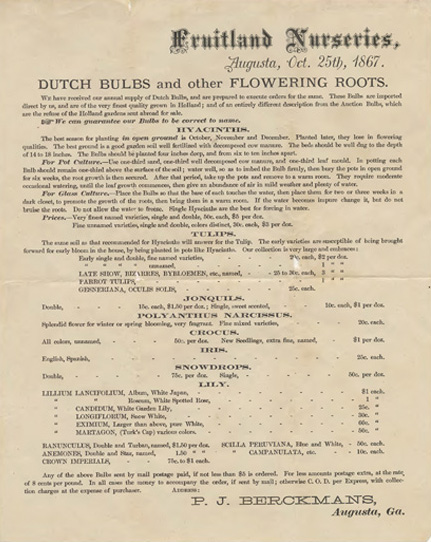
Founded in 1858 by Belgian immigrant Louis Mathieu Edouard Berckmans and his son, Prosper Jules Alphonse Berckmans, Fruitland introduced an array of fruit varieties, including the Chinese Cling, Elberta, Belle and Thurber peaches. P. J. Berckman's importation of ten amur privet hedges (Ligustrum amurense) from France in 1860 proved to be the beginning of all the privet hedges now thriving throughout the American South. In this 1867 catalog, Fruitland offered a variety of imported flowering bulbs, including "jonquils" (singles and doubles) and "polyanthus narcissuses" (paperwhites). Today, the Augusta National Golf Club, home of the Masters Tournament, occupies the former Fruitland Nurseries property.
By 1822, William Prince of Flushing, New York, offered named daffodils, not just "sorts" by general category. His catalog included 64 tazettas, fourteen singles, six doubles and four jonquils (single and double).
There is record of one such well-to-do southern gardener ordering from a catalog or seedsman. Henry Middleton, of Middleton Place, near Charleston, South Carolina, placed a seed order in the early 1800s. Included in his large order (well into the hundreds of items) of perennials, herbs, vegetables, hothouse plants and bulbs were narcissuses. He ordered one polyanthus narcissus (N. tazetta), three doubles (including the still-grown 'Orange Phoenix'), one "poet" (N. poeticus) and one small yellow trumpet (N. minor).
A woman of more modest means was Mistress Hannah Howard. In 1785, she purchased a cabin and land outside of Augusta, Georgia. She busily set out to improve the property with gardens, including a formal parterre style bulb garden, described by some as in "the old Dutch style." This design is comprised of a circle inside a square, so a center round bed surrounded by four square/rectangular beds with the inner corners rounded to concave curves. Mrs. Howard then added linear beds around the center design, retaining the two main axis for the walking paths.
It has to be taken with a modicum of faith that no one in the family added any daffodils or other bulbs to the garden (prior to 1933), and that the garden itself pre-dates 1800. Making the assumption that all of the family women after Hannah Howard respected and protected her garden, then it becomes a very interesting time capsule indeed.
The center bed was planted with yellow trumpet daffodils. The four beds immediately surrounding the circle were planted in 'Butter and Eggs', the all-yellow double, and bordered in Roman hyacinths and Spanish bluebells. Instead of boxwood, the parterre sections were edged in spice pinks and blue hyacinths. The tulips, being tulips in the South, did not survive, and the pinks similarly died out. But the daffodils, being daffodils, were all still merrily blooming in 1933, under the watchful eye of Mrs. Howard's great-great-granddaughter. The beds were overplanted in the summer, but unfortunately the knowledge of what plants were used has been lost. Images of her garden taken in 1933 can be found in the Smithsonian Institution's online archives.
By 2009, the garden form had survived, but not most of the daffodils, having been tilled up to make way for roses. Fortuitously, a few back beds were not tilled, and were filled with a few Paperwhites, snowflakes (Leucojum aestivum), jonquils (N. x odorus), a very uncommon all-white tazetta (as yet unidentified), lots of the tazetta 'Grand Monarque' and a very few gladiolus. The mid-season trumpets bloomed after the 'Grand Monarque'. Many Spanish bluebells survived, as well as a few Roman hyacinths. Many of the center bed's trumpets survived. Unfortunately, only one 'Butter and Eggs' survived in the four surrounding beds. So, while we tend to think of spring bulbs as a quick flush of early color, the garden actually started blooming in December with Paperwhites, then transitioned to early spring with 'Grand Monarque', N. x odorus and Roman hyacinths, and finished in March with 'Butter and Eggs', the center trumpets and Spanish bluebells.
There is record of one such well-to-do southern gardener ordering from a catalog or seedsman. Henry Middleton, of Middleton Place, near Charleston, South Carolina, placed a seed order in the early 1800s. Included in his large order (well into the hundreds of items) of perennials, herbs, vegetables, hothouse plants and bulbs were narcissuses. He ordered one polyanthus narcissus (N. tazetta), three doubles (including the still-grown 'Orange Phoenix'), one "poet" (N. poeticus) and one small yellow trumpet (N. minor).
A woman of more modest means was Mistress Hannah Howard. In 1785, she purchased a cabin and land outside of Augusta, Georgia. She busily set out to improve the property with gardens, including a formal parterre style bulb garden, described by some as in "the old Dutch style." This design is comprised of a circle inside a square, so a center round bed surrounded by four square/rectangular beds with the inner corners rounded to concave curves. Mrs. Howard then added linear beds around the center design, retaining the two main axis for the walking paths.
It has to be taken with a modicum of faith that no one in the family added any daffodils or other bulbs to the garden (prior to 1933), and that the garden itself pre-dates 1800. Making the assumption that all of the family women after Hannah Howard respected and protected her garden, then it becomes a very interesting time capsule indeed.
The center bed was planted with yellow trumpet daffodils. The four beds immediately surrounding the circle were planted in 'Butter and Eggs', the all-yellow double, and bordered in Roman hyacinths and Spanish bluebells. Instead of boxwood, the parterre sections were edged in spice pinks and blue hyacinths. The tulips, being tulips in the South, did not survive, and the pinks similarly died out. But the daffodils, being daffodils, were all still merrily blooming in 1933, under the watchful eye of Mrs. Howard's great-great-granddaughter. The beds were overplanted in the summer, but unfortunately the knowledge of what plants were used has been lost. Images of her garden taken in 1933 can be found in the Smithsonian Institution's online archives.
By 2009, the garden form had survived, but not most of the daffodils, having been tilled up to make way for roses. Fortuitously, a few back beds were not tilled, and were filled with a few Paperwhites, snowflakes (Leucojum aestivum), jonquils (N. x odorus), a very uncommon all-white tazetta (as yet unidentified), lots of the tazetta 'Grand Monarque' and a very few gladiolus. The mid-season trumpets bloomed after the 'Grand Monarque'. Many Spanish bluebells survived, as well as a few Roman hyacinths. Many of the center bed's trumpets survived. Unfortunately, only one 'Butter and Eggs' survived in the four surrounding beds. So, while we tend to think of spring bulbs as a quick flush of early color, the garden actually started blooming in December with Paperwhites, then transitioned to early spring with 'Grand Monarque', N. x odorus and Roman hyacinths, and finished in March with 'Butter and Eggs', the center trumpets and Spanish bluebells.
Daffodils Are Planted Across the Region
As early pioneer settlers spread across the South, gardeners took favorite plants along with them, but written records of these are scarce. In her 1838-1839 diary, Fanny Kemble of coastal Georgia noted jonquils in the garden of a woman transplanted from New England. Kemble delighted in jonquils and silvery narcissus blooming in January and February, 1839, on St. Simons Island, at Darien and on Butler Island. One such observation was made on February 11, 1839: "On a visit I had to make on the mainland, I saw a tiny strip of garden ground, rescued from the sandy road, called a street, perfectly filled with hyacinths, double jonquils and snowdrops, a charming nosegay."
But perhaps the most touching diary entry belongs to Mrs. Sarah Espy in her 1859 diary, when she lived in eastern Alabama. She wrote, "Feb. 20, Ice this morning, yet I see the yellow jonquils are in bloom, mother's favorite flower, which she more than 50 years ago brought with her from North Carolina."
In antebellum Alabama, Georgia and across the South, daffodils appeared in the gardens of the rich and the moderately well-off. The wealthy emulated the European parterre designs, and daffodils and other Dutch bulbs were planted within a box bordered bed (each bed of the overall design was often dedicated to a single variety or type of plant) or as borders to the box beds. But exceptions are always to be found. In 1854, Mr. George Camp wrote of the "hedge of jonquils" planted by Catherine (wife of a town founding father, Barrington King) at the grand Barrington Hall in Roswell. The current garden curator hopes the remnants of this line has been identified and saved, due to careful overseeing of spring mowing. The line appears just outside the formal box parterre garden, in front of a spirea hedge.
The less well-off would have had a front yard or dooryard, fenced to keep out the livestock, and daffodils were simply part of the mix of garden plants. Daffodils appear in Alabama women's seminary botany press books in the 1850s, such as the 1858 Herbarium of Fannie A. Nelms, while a student at the Marion Female Seminary in Perry County. The most common flower is N. x odorus (commonly known as "Campernelle"); a poet is included but unfortunately cannot be positively identified as to exactly which one.
But high or low, the type of daffodil remained the same, and these self-same treasures of families gone by can still be found across the South, keeping vigil over many an abandoned or obliterated home.
As early pioneer settlers spread across the South, gardeners took favorite plants along with them, but written records of these are scarce. In her 1838-1839 diary, Fanny Kemble of coastal Georgia noted jonquils in the garden of a woman transplanted from New England. Kemble delighted in jonquils and silvery narcissus blooming in January and February, 1839, on St. Simons Island, at Darien and on Butler Island. One such observation was made on February 11, 1839: "On a visit I had to make on the mainland, I saw a tiny strip of garden ground, rescued from the sandy road, called a street, perfectly filled with hyacinths, double jonquils and snowdrops, a charming nosegay."
But perhaps the most touching diary entry belongs to Mrs. Sarah Espy in her 1859 diary, when she lived in eastern Alabama. She wrote, "Feb. 20, Ice this morning, yet I see the yellow jonquils are in bloom, mother's favorite flower, which she more than 50 years ago brought with her from North Carolina."
In antebellum Alabama, Georgia and across the South, daffodils appeared in the gardens of the rich and the moderately well-off. The wealthy emulated the European parterre designs, and daffodils and other Dutch bulbs were planted within a box bordered bed (each bed of the overall design was often dedicated to a single variety or type of plant) or as borders to the box beds. But exceptions are always to be found. In 1854, Mr. George Camp wrote of the "hedge of jonquils" planted by Catherine (wife of a town founding father, Barrington King) at the grand Barrington Hall in Roswell. The current garden curator hopes the remnants of this line has been identified and saved, due to careful overseeing of spring mowing. The line appears just outside the formal box parterre garden, in front of a spirea hedge.
The less well-off would have had a front yard or dooryard, fenced to keep out the livestock, and daffodils were simply part of the mix of garden plants. Daffodils appear in Alabama women's seminary botany press books in the 1850s, such as the 1858 Herbarium of Fannie A. Nelms, while a student at the Marion Female Seminary in Perry County. The most common flower is N. x odorus (commonly known as "Campernelle"); a poet is included but unfortunately cannot be positively identified as to exactly which one.
But high or low, the type of daffodil remained the same, and these self-same treasures of families gone by can still be found across the South, keeping vigil over many an abandoned or obliterated home.
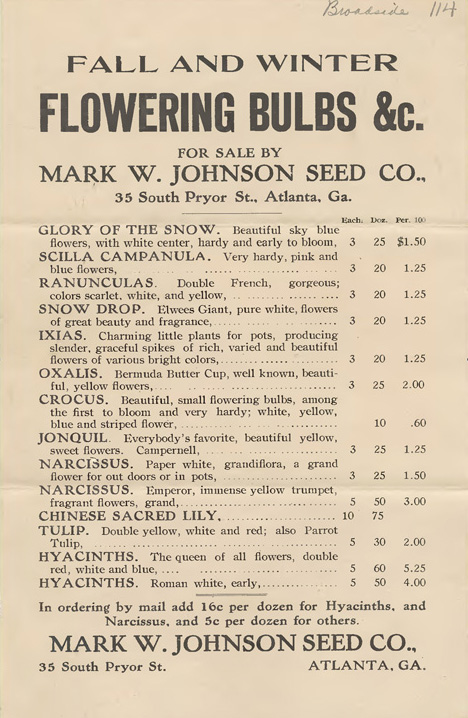
Atlanta-based Mark W. Johnson Seed Company, in this undated catalog, offered "jonquils" (Campernelle or Narcissus x odorus), paperwhites and the 1869 cultivar, 'Emperor'.
Period appropriate flowers for historic southern gardens with approximate dates of introduction, as of current research (and so subject to change):
1700s
N. pseudonarcissus (Brother Lung 1749)
'Plenus' - old name "Albus Plenus Odorutus" (1735); note: does not grow well in the South.
Varigated double narcissus (reasonable to guess: 'Butter and Eggs', 'Orange Phoenix' and 'Sulphur Phoenix') (Lady Skipworth 1793)
Double Jonquil - 'Flore Pleno' (Lady Skipworth 1793)
By 1800
'Butter and Eggs' (Hannah Howard)
'Grand Monarque' (Hannah Howard)
Paperwhites (Hannah Howard)
N. x odorus (Hannah Howard)
N. tazetta (Henry Middleton)
'Orange Phoenix' (Henry Middleton)
N. minor (Henry Middleton)
N. poeticus (Henry Middleton)
By 1810
N. papyraceus (species Paperwhites) (Louis LeConte)
N. jonquilla (Louis LeConte)
'Sulphur Phoenix' (Louise LeConte)
'Butter and Eggs' (Louis LeConte)
'Plenus' - old name N. pseudonarcissus flore pleno (Louis Leconte)
'Eystettensis' - old name N. minor flore pleno, or Gallicus minor flore pleno (Louis LeConte)
Sold in America by Bernard M'Mahon, 1806:
N. poeticus Poetic or white narcissus
N. Pseudo-Narcissus Common daffodil
N. bicolor Two-coloured narcissus
N. minor Small narcissus
N. biflorus Two-flowered do.
N. triandrus Rush-leaved do.
N. orientalis Oriental do. (now regarded as N. tazetta var. lacticolor)
N. odorus Sweet-scented do.
N. tazetta Polyanthus Narcissus
N. bulbocodium Hoop-petticoat do.
N. jonquilla Jonquil (single and double)
N. serotinus Late-flowering Narcissus
N. moschatus Musk-scented do.
1700s
N. pseudonarcissus (Brother Lung 1749)
'Plenus' - old name "Albus Plenus Odorutus" (1735); note: does not grow well in the South.
Varigated double narcissus (reasonable to guess: 'Butter and Eggs', 'Orange Phoenix' and 'Sulphur Phoenix') (Lady Skipworth 1793)
Double Jonquil - 'Flore Pleno' (Lady Skipworth 1793)
By 1800
'Butter and Eggs' (Hannah Howard)
'Grand Monarque' (Hannah Howard)
Paperwhites (Hannah Howard)
N. x odorus (Hannah Howard)
N. tazetta (Henry Middleton)
'Orange Phoenix' (Henry Middleton)
N. minor (Henry Middleton)
N. poeticus (Henry Middleton)
By 1810
N. papyraceus (species Paperwhites) (Louis LeConte)
N. jonquilla (Louis LeConte)
'Sulphur Phoenix' (Louise LeConte)
'Butter and Eggs' (Louis LeConte)
'Plenus' - old name N. pseudonarcissus flore pleno (Louis Leconte)
'Eystettensis' - old name N. minor flore pleno, or Gallicus minor flore pleno (Louis LeConte)
Sold in America by Bernard M'Mahon, 1806:
N. poeticus Poetic or white narcissus
N. Pseudo-Narcissus Common daffodil
N. bicolor Two-coloured narcissus
N. minor Small narcissus
N. biflorus Two-flowered do.
N. triandrus Rush-leaved do.
N. orientalis Oriental do. (now regarded as N. tazetta var. lacticolor)
N. odorus Sweet-scented do.
N. tazetta Polyanthus Narcissus
N. bulbocodium Hoop-petticoat do.
N. jonquilla Jonquil (single and double)
N. serotinus Late-flowering Narcissus
N. moschatus Musk-scented do.
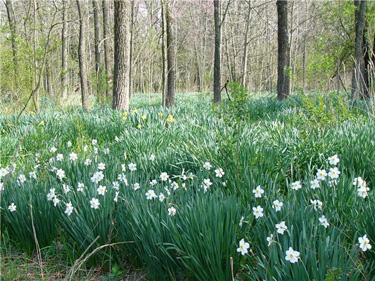
This photograph was taken in March 2009 at the former Jones Floral Farm. Mrs. Jones sold cut flowers to the northern markets from her place outside Calhoun, Georgia, from the 1920s until her death in the late 1940s. Reportedly, she grew 26 varieties, all old cultivars and species, back in the day. At the time of this photograph, there were 8 varieties in bloom, including 'Emperor', 'Actaea', 'Stella', 'Orange Phoenix', 'Sulphur Phoenix', 'Telamonius Plenus', Narcissus x odorus and the 1870 French cultivar, 'Ornatus' (pictured in the foreground above).
BIBLIOGRAPHY
William Darlington. Memorials of John Bartram and Humphry Marshall. (Philadelphia: Lindsay and Blakiston, 1849).
Alice Morse Earle. Old Time Gardens Newly Set Forth (New York: The MacMillan Company, 1901).
Fanny Kemble. Journal of a Residence on a Georgian Plantation in 1838-1839 (University of Virginia Library, Electronic Text Center).
Bernard M'Mahon. The American Gardener's Calendar: Adapted to the Climates and Seasons of the United States (Philadelphia: Bernard M'Mahon, Seedsman and Florist, 1806).
William Prince. Catalogue of Fruit and Ornamental Trees and Plants, Bulbous Flower Roots, Green House Plants, etc., etc., 1882.
Alexander S. Salley Jr. Narratives of Early Carolina 1650-1708 (New York: Charles Scribner's Sons, 1911).
"Berckmans Nursery," New Georgia Encyclopedia. Retrieved March 27, 2009: http://www.newgeorgiaencyclopedia.org
History of Georgia Gardens 1733-1933 (Garden Club of Georgia, 1933).
Southern Plant Lists, Gordon W. Chappell, Editor. Southern Garden History Society in a Joint Project with The Colonial Williamsburg Foundation, September 2000).
OTHER RESOURCES
Broadside Collection, University of Georgia Archives, Hargrett Library, Athens, Georgia.
George Stritikus Collection, Cherokee Garden Library, Atlanta History Center, Atlanta, Georgia.
HELPFUL LINKS
Southern Garden History Society---Southern Plants List
Barrington Hall, Roswell, Georgia
LeConte Woodmanston Plantation
William Darlington. Memorials of John Bartram and Humphry Marshall. (Philadelphia: Lindsay and Blakiston, 1849).
Alice Morse Earle. Old Time Gardens Newly Set Forth (New York: The MacMillan Company, 1901).
Fanny Kemble. Journal of a Residence on a Georgian Plantation in 1838-1839 (University of Virginia Library, Electronic Text Center).
Bernard M'Mahon. The American Gardener's Calendar: Adapted to the Climates and Seasons of the United States (Philadelphia: Bernard M'Mahon, Seedsman and Florist, 1806).
William Prince. Catalogue of Fruit and Ornamental Trees and Plants, Bulbous Flower Roots, Green House Plants, etc., etc., 1882.
Alexander S. Salley Jr. Narratives of Early Carolina 1650-1708 (New York: Charles Scribner's Sons, 1911).
"Berckmans Nursery," New Georgia Encyclopedia. Retrieved March 27, 2009: http://www.newgeorgiaencyclopedia.org
History of Georgia Gardens 1733-1933 (Garden Club of Georgia, 1933).
Southern Plant Lists, Gordon W. Chappell, Editor. Southern Garden History Society in a Joint Project with The Colonial Williamsburg Foundation, September 2000).
OTHER RESOURCES
Broadside Collection, University of Georgia Archives, Hargrett Library, Athens, Georgia.
George Stritikus Collection, Cherokee Garden Library, Atlanta History Center, Atlanta, Georgia.
HELPFUL LINKS
Southern Garden History Society---Southern Plants List
Barrington Hall, Roswell, Georgia
LeConte Woodmanston Plantation
Author: Sara Van Beck. Published March 27, 2009.
Copyright
Southern Edition
All Rights Reserved
Southern Edition
All Rights Reserved
All materials contained on this site, including text and images, are protected by copyright laws and may not be reproduced without prior written permission from the publisher. Where applicable, use of some items contained on this site may require permission from other copyright owners.
Fair Use of text from SouthernEdition.com is permitted to the extent allowed by copyright law. Proper citation is requested. Please use this guide when citing a Southern Edition article.
Contact Greg Freeman or SouthernEdition.comFair Use of text from SouthernEdition.com is permitted to the extent allowed by copyright law. Proper citation is requested. Please use this guide when citing a Southern Edition article.